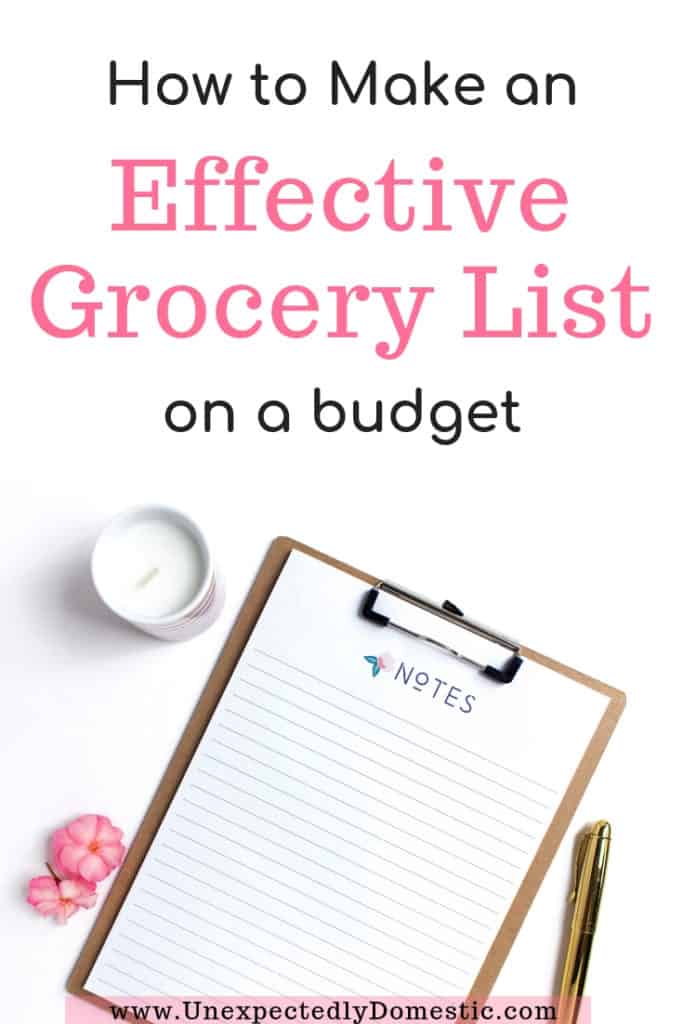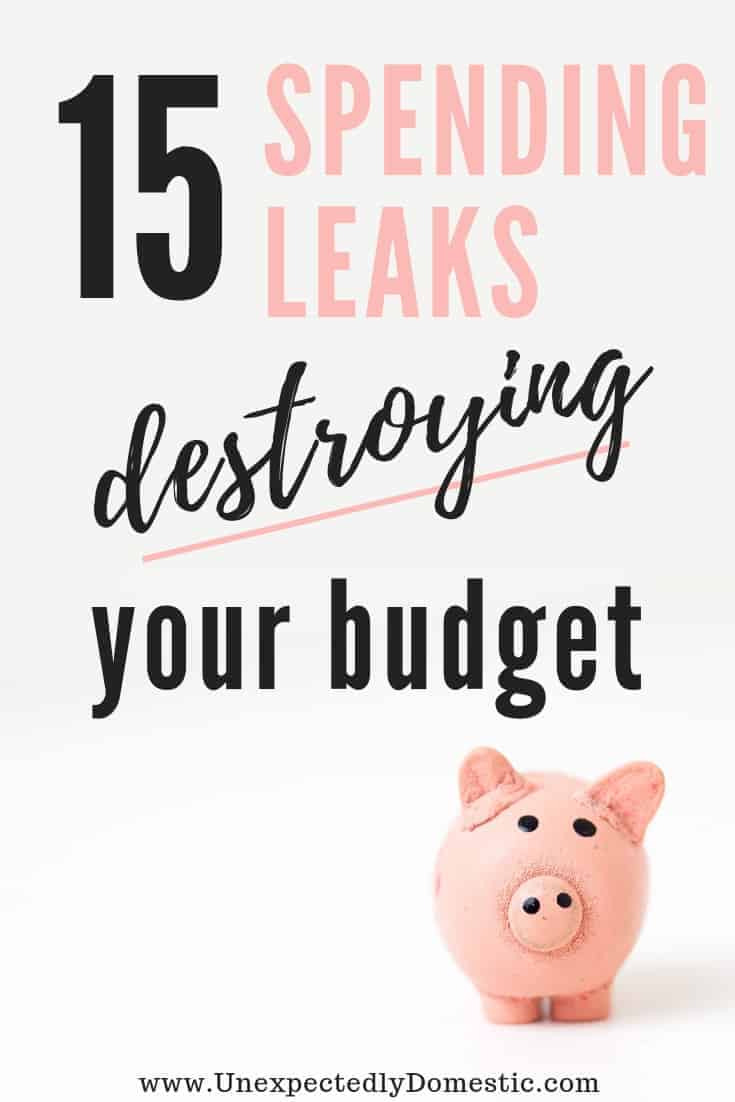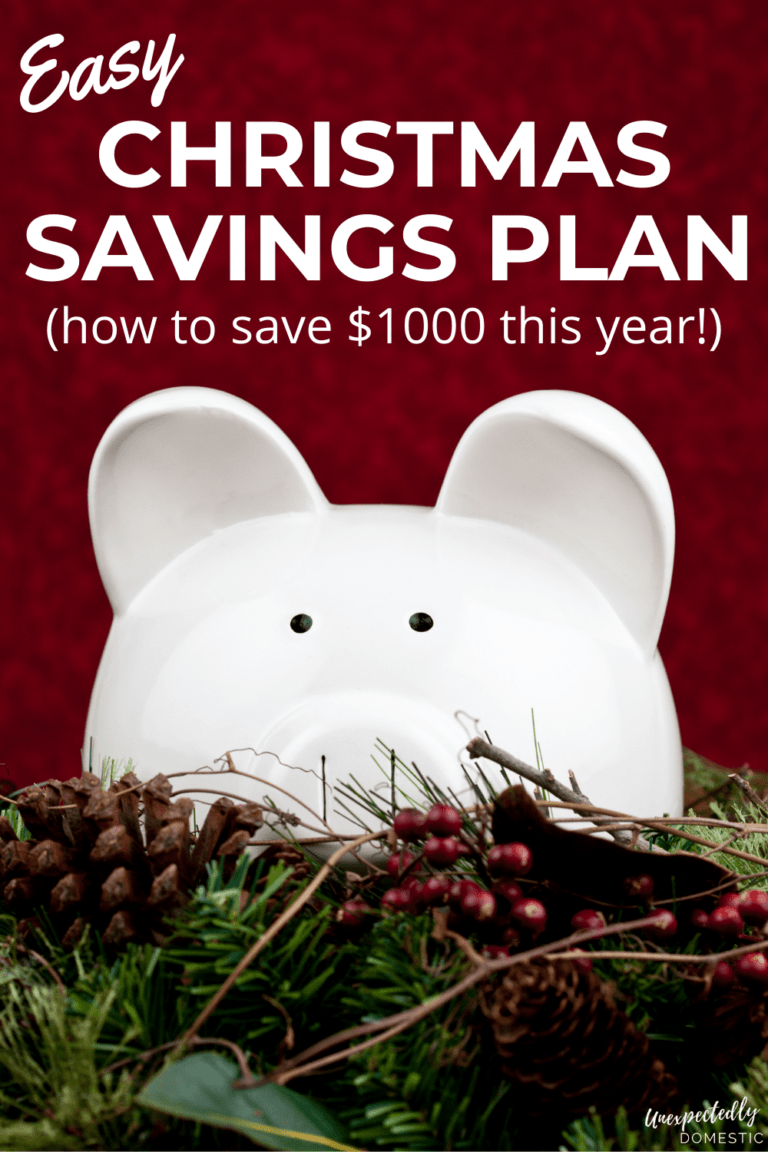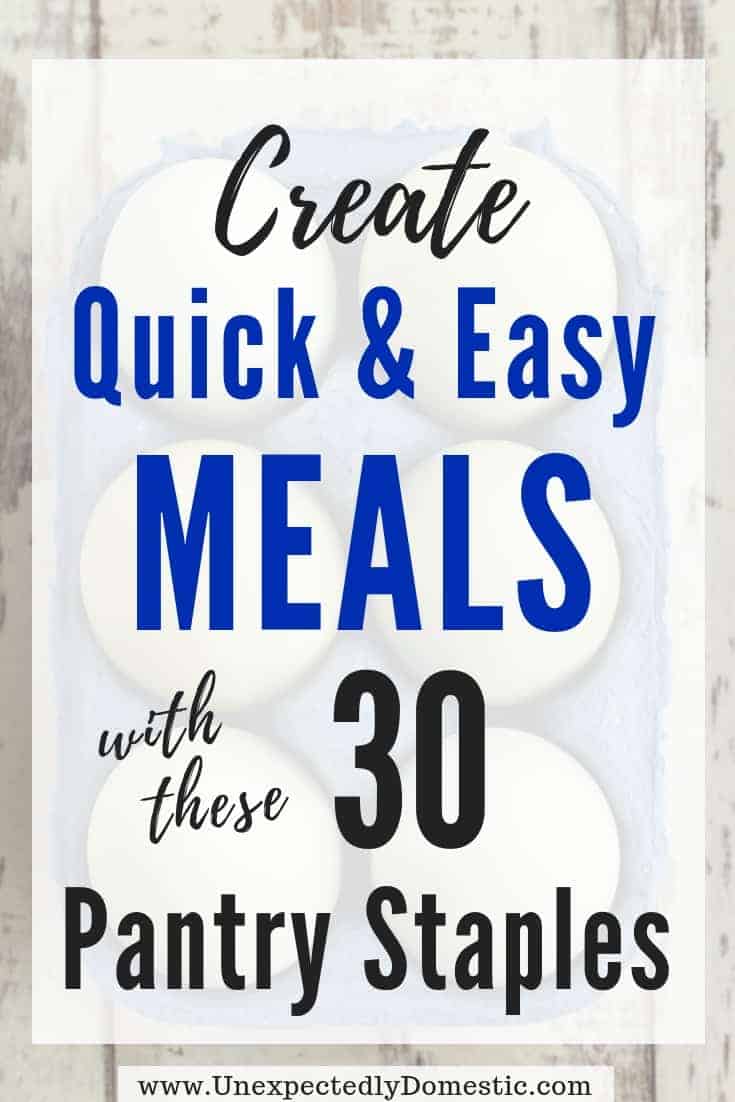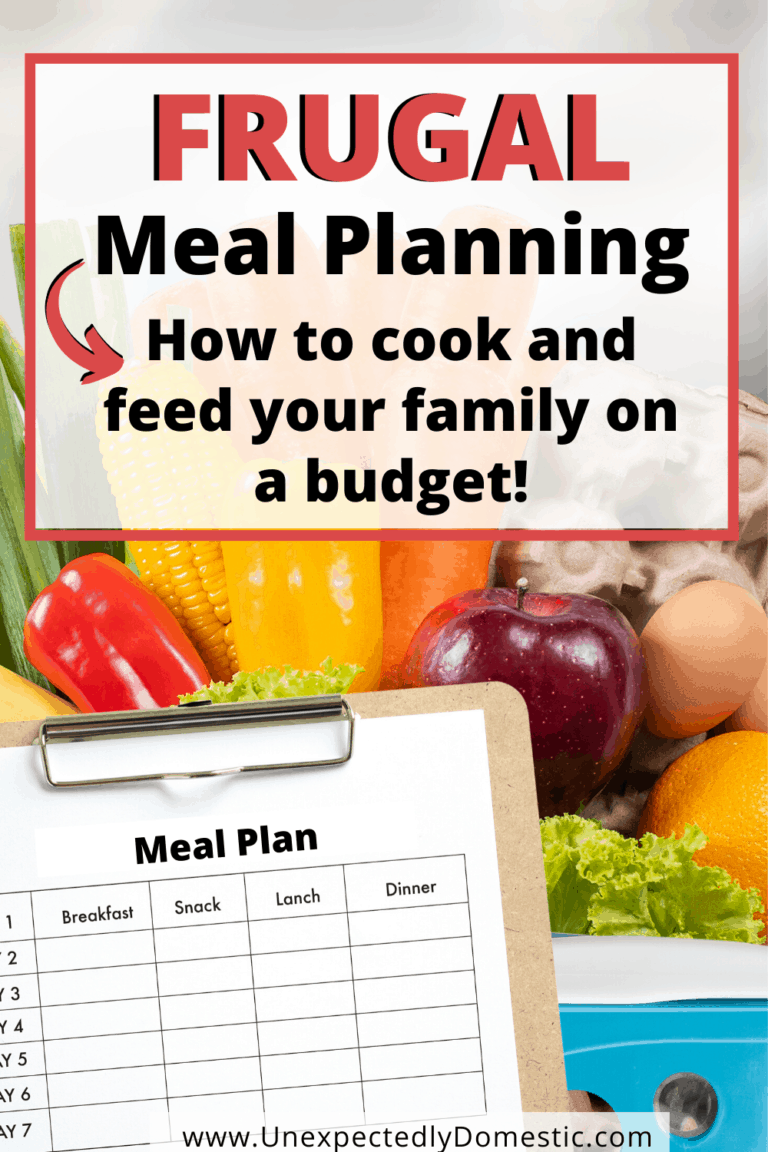75+ Cheap Grocery List Ideas (the cheapest foods to buy on a budget!)
List of the cheapest groceries to buy when you’re on a tight budget! This budget grocery list includes the most affordable foods at the supermarket so you can eat well and save money.
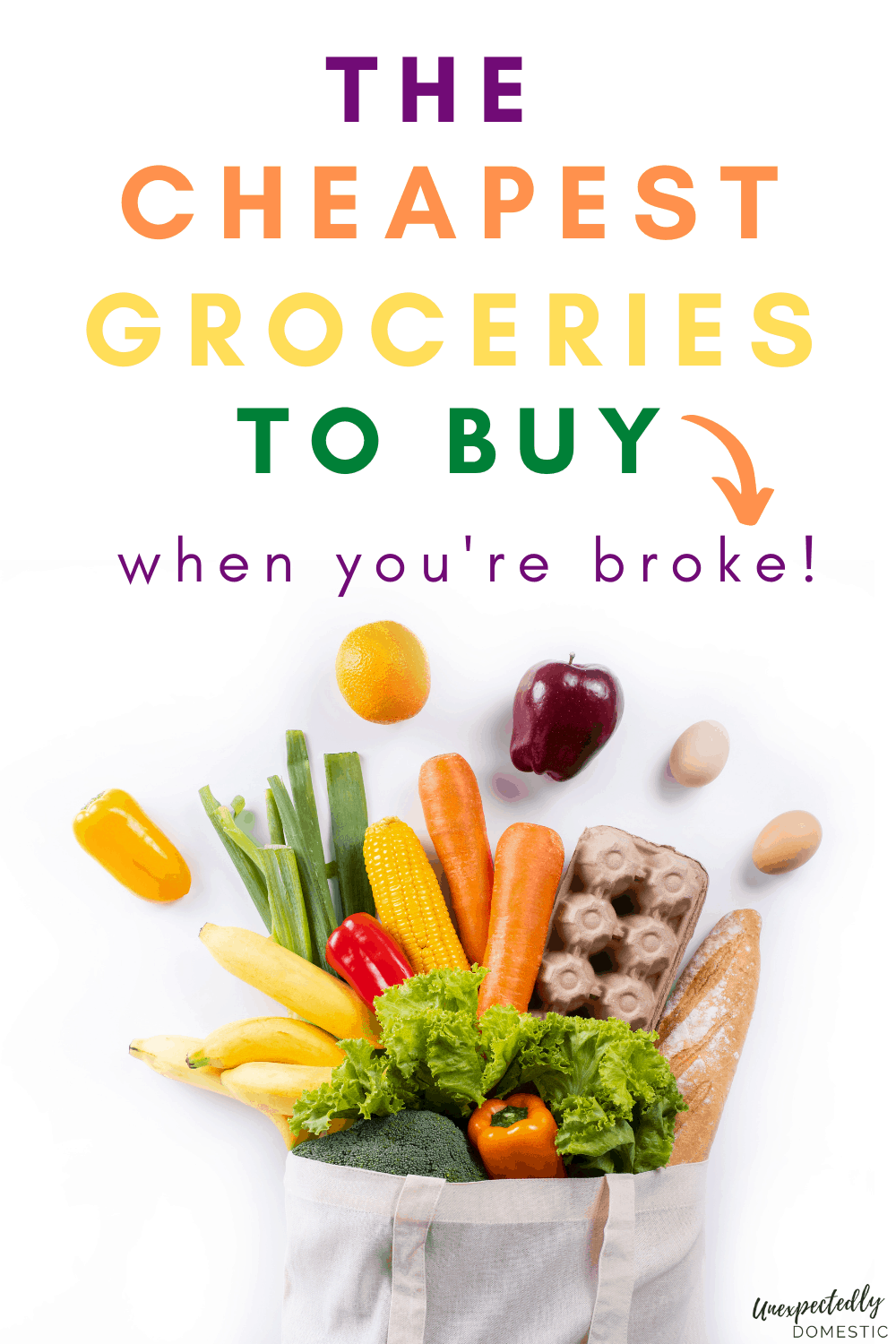
Ya know when you feel like your budget is stretched to its limits…
…and then you realize you still have to buy groceries for the month?
Believe me, I’ve been there.
But after a lot of trial and error, I finally figured out how to make a cheap grocery shopping list, and I want to share these cheap food ideas with you!
(Plus, get tons of grocery list ideas, tips for healthy snacks, family meals, and how to buy nutrient-dense foods, and where you can grab your own master grocery list.)
Why buy the cheapest foods?
When money is tight, one of the BEST places to cut back on is your food spending.
You are in control of how much you spend on groceries, so buying the cheapest groceries and cooking at home is a great way to completely transform how much money you can save.
Saving money on groceries means you can:
- Pay off debt
- Get caught up on bills
- Save up for something big like a vacation, new home, or a wedding
- Create an emergency fund
- Save for retirement or your future
- Just have more money to spend on fun stuff
You can also buy these cheap groceries to build a stockpile to prepare for emergencies, job loss, and any hard times you may experience.
This budget grocery list is filled with pantry and freezer staples that would make great additions to your stockpile.
Where to buy cheap groceries
When you’re grocery shopping on a budget, the store you choose REALLY matters.
Try to find the cheapest supermarkets in your area, so that you can save money just by shopping there instead of somewhere pricier.
The cheapest supermarkets are:
- Aldi
- Walmart
- Trader Joe’s
- Costco
- Food4Less
- WinCo
- Lidl
I personally feel that the best grocery store to shop on a budget is Aldi. They’re prices are automatically about 40% cheaper than other stores.
The CHEAPEST Groceries You Can Buy
If you’ve ever wondered ‘what groceries should I buy’ when trying to eat on a budget…
…here’s a list of the cheapest foods, so you can make your budget grocery list fast and easily!
- Oatmeal
- Cream of wheat
- Eggs
- Bread
- Cereal
- Bananas
- Apples
- Dried beans
- Dried lentils
- Brown or white rice
- Boxed pasta
- Russet potatoes
- Sweet potatoes
- Carrots
- Canned tomatoes (diced or stewed)
- Butternut squash
- Zucchini
- Onions
- Broccoli
- Salsa
- Chicken thighs or legs
- Ground turkey
- Green salad
- Spinach (bagged or frozen)
- Bell peppers
- Frozen vegetables
- Kale
- Garlic
- Canned pumpkin
- Peanut butter
- Canned tuna
- Oranges
- Cantaloupe
- Kiwi
- Watermelon
- Grapes
- Frozen berries
- Cabbage
- Garden vegetables
- Milk
- Yogurt
- Cottage cheese
- Cheese
- Canned beans (refried, black, pinto, chili, or kidney)
- Edamame
- Corn
- Quinoa
- Flour
- Sugar
- Popcorn
- Pork
- Ground beef
- Peanuts
- Seasonings
- Hot dogs
- Macaroni and cheese
- Ramen noodles
- Tomato sauce or paste
- Tofu
- Lettuce
- Tortillas
- Cornmeal
- Bouillon cubes or powder
- Broth
- Spices
- Canned fruit
- Pasta sauce
- Macaroni and cheese
- Generic brand cereal
- Yeast
- Cucumbers
- Canned chicken
- Baking soda & baking powder
- Tea bags
- Sour cream
As you can see, you can still buy healthy food, such a fresh fruits, whole grains, and nut butters to make a ton of healthy meals.
Now that you’re armed with a list of the cheapest foods at the grocery store, let’s check out some tips for grocery shopping on a budget!
How to Grocery Shop on a Budget
Set a budget
The very first step in making your cheap grocery list is knowing how much you can actually spend.
Having a budget boils down to simply having a plan. That structure will help determine what you buy.
Food just might be one of your biggest expenditures. The good news? It’s also one of the easiest to control. That’s where the budget comes into play.
Read next: How to Budget for Groceries
Shop the sales
I’ll let you in on a little secret.
The biggest savings at the grocery store actually comes from the sale prices. While I love coupons and rebate apps like Ibotta, the sales are where the biggest discounts are.
Related: How does Ibotta work? A Review and Tutorial of My Favorite Rebate App
See, every week your grocery store has what are called ‘loss leaders.’ These are items that they make little to no money on (or maybe even take a loss).
Can you guess why they do that?
If you guessed it’s because they want you to come in for that deeply discounted item or two and buy tons of other stuff at full price, you’re right.
Well the joke is on them if we go and buy almost entirely stuff on sale!
👉 That is the best way to grocery shop on a tight budget.
So be sure to take a good look at your store’s sales ad. If it doesn’t get mailed to your house, it’ll be available on their app or website.
Pro-tip: If there are a few different stores in your area, check out ALL of their sales ads to decide which store has your favorite stuff on sale. The best prices tend to be on the front and back pages.
💡 I recently discovered the Flipp app, where you can see all the sales ads in your area. You can even search by item, such as chicken breasts, to compare what stores have it on sale. Genius!
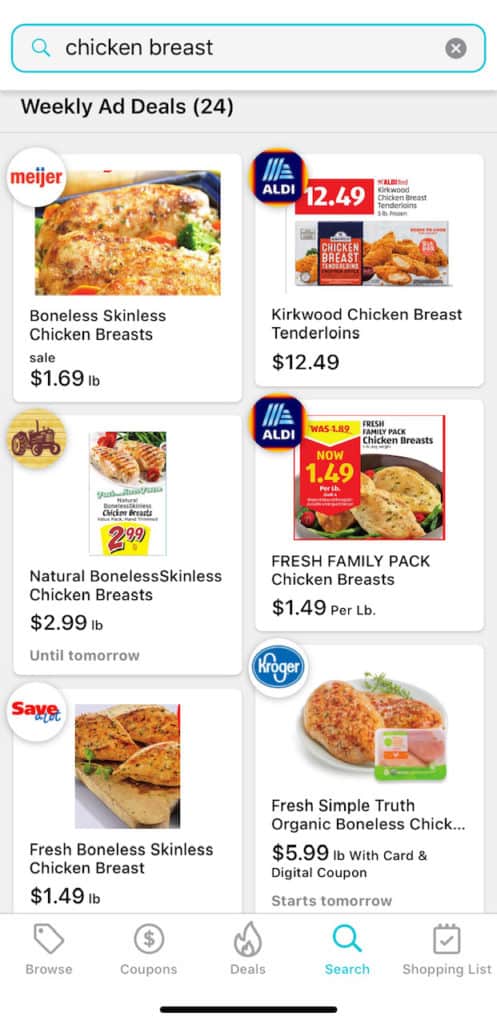
Compare prices
As you shop, check out the other brands and sizes on the shelf to make sure you’re getting the best deal.
Look at the ‘cost per unit’ on the shelf price tag. It’ll usually tell you how much per ounce or quantity, so you can quickly compare different sizes and brands.
If the shelf tag doesn’t list the cost per unit, you can divide the total price by the number of ounces or items.
List prices as you shop
While shopping, write down the cost of each item on your list. It doesn’t have to be exact, but that way you can keep a running tally of how much you’re spending as you go.
Then you can put anything back that doesn’t fit in your budget, or find a cheaper option to swap it with.
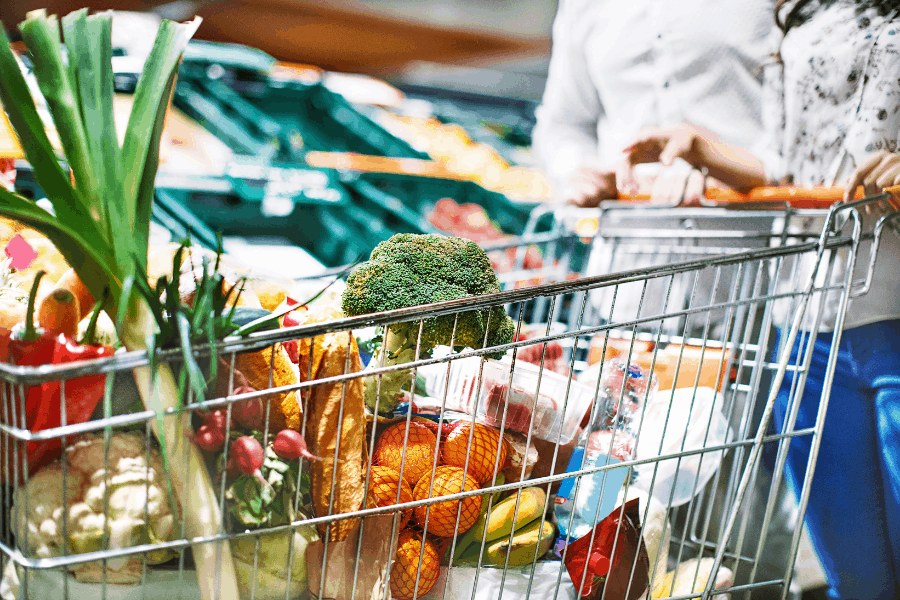
Keep a price list
For the items you buy often, start keeping a list of the best prices you see.
Try to only buy those items when they’re on sale for those prices.
Avoid buying pre-packaged stuff
You know that really convenient cut up fruit, and those individually packaged pretzels?
You really pay a premium for the convenience.
Just chop it or put it in Ziploc baggies yourself, and you’ll save so much!
Buy produce in season
Fruits and vegetables are SO much cheaper (and more delicious!) when they’re in season.
Since you’re basing some of your grocery list on what’s on sale, you can enjoy the tastiest produce at its peak.
Don’t shop when you’re hungry
You know those Snickers commercials that say ‘you’re not you when you’re hungry?’
Low blood sugar notwithstanding, you’re just more apt to make poor decisions and way overspend on groceries if you shop hungry.
Buy generic brand
Don’t worry, the generic or store brands aren’t gross or anything.
In fact, they’re often made by the brand name company, but sold without the fancy packaging or expensive prime shelf space.
The good news for you? They’re often up to 40% cheaper! That’s one of the main reasons I love shopping at Aldi. You just save money automatically!
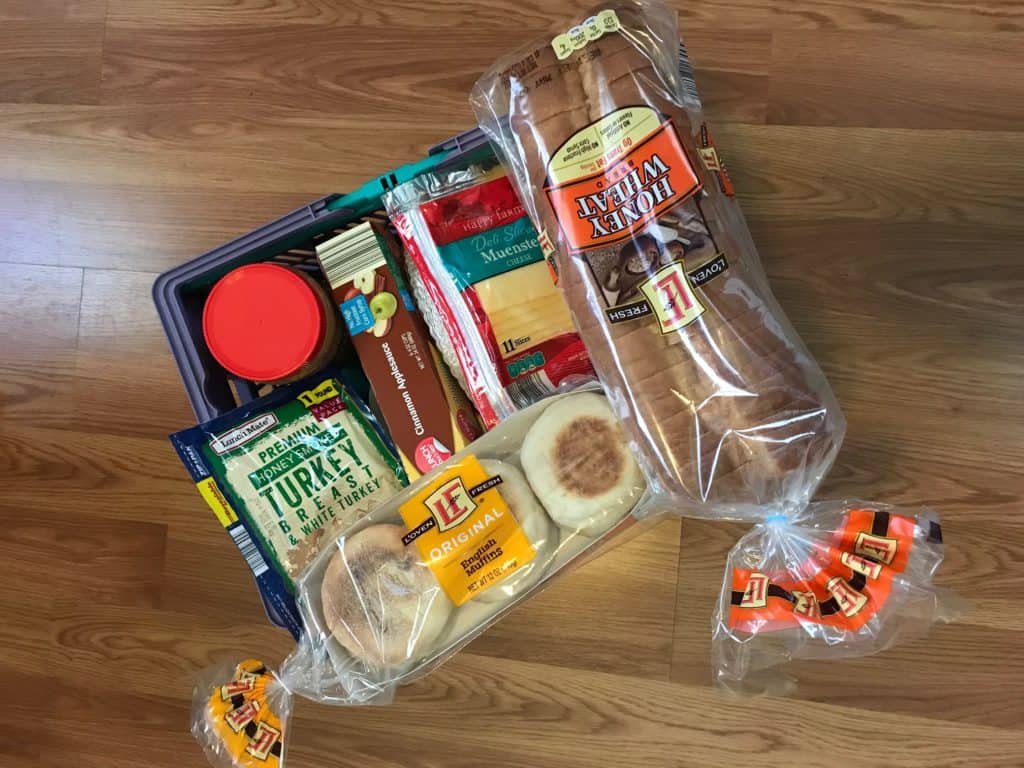
Use a master grocery list
To ensure you never forget anything (and have to run back to the store) use a master grocery list.
Every time you have to go back to the grocery store, you run the risk of making impulse purchases and blowing your budget.
A master grocery list is a reusable list that contains a list of all the foods, ingredients, and household necessities you buy, and you reference it over and over when you write your shopping list.
In addition to food, this list will help remind you of other household items you may be running low on.
Grab a FREE printable master grocery list below!
Use coupons wisely
Trust me, I love using coupons. It feels like a game, or like I’m beating the system or something.
But the danger comes when you buy things just because you have a coupon.
If it’s not free (or almost free), or you weren’t planning to buy it anyway, or have an immediate use for it, just leave it at the store.
Stick to your list
The final key to your success will be how well you use the cheap grocery list you created.
Whatever you do, do NOT walk up and down each aisle looking at everything. That is recipe for budget disaster.
Keep a laser-like focus on your list, and get in and get out.
Pro-tip: If you love Ibotta like I do, don’t forget to cash in those rebates!

Meal Planning on a Tight Budget
Meal planning will help you plan ahead so you’re not scrambling at dinner time. Plus it’ll help eliminate food waste, so you’re not throwing away foods you spent hard-earned money on.
Here are some tips for meal planning when you’re trying to stick within your budget.
Make a list of Frugal Meals
Keep a list of dirt cheap meals you can cook for cheap.
This makes budget meal planning go so fast!
You’ll already have a master list of dinners you can pull from each week, so planning your menu can happen in minutes.
Take inventory of what you have
Now that you know what you can spend, the next step in creating your basic grocery list is figuring out what you already have at home.
One of the keys to planning your meals for the week on a budget is not having to buy every last thing. You probably have some meals already hiding in your pantry, fridge, and freezer.
Read Next: Learn How to Save Money This Month with a Pantry Challenge
Here’s an example of how this inventory-taking might look.
Let’s say you look in your pantry and find:
- Pasta
- Canned tomatoes
- Rice
- Chicken broth
And in your freezer you see:
- Chicken breasts
- Hashbrowns
- Frozen fruit
- Leftover ham
Maybe your fridge has:
- Shredded cheese
- Eggs
- Celery
Off the top of my head, it looks like you could make these dinners:
- Chicken with rice soup
- Spaghetti
- Hashbrown casserole (with fruit as a side dish)
That’s 3 meals (more if you have leftovers) you don’t have to spend money on!
Write out your meal plan
Once you’ve inventoried what you have on hand, you can start writing your meal plan.
The idea is just to start assigning meals to the days of the week. Even if you end up moving things around, it’s just easiest to see it laid out like this.
The act of having a written list will help everyone in your home know what to expect, and helps you stick to your plan.
Simultaneously start making your grocery list
As you go about creating your meal plan, you’ll also be making your grocery list.
First, add any ingredients you’ll need to complete the meals you wrote down from your pantry inventory.
Using the example given above, maybe you also need:
- Ground beef or turkey to make spaghetti
- Garlic bread
- Carrots for the chicken soup
These are the beginnings of your healthy grocery list. Don’t forget to write down the ingredients for any side dishes you plan to make with those meals.
Check the sales ad
Okay, you have come up with a few meals based on what you already have, and started making your list.
Now you can peruse the sales flyer for more inspiration.
The more meals you can make out of the sale-priced items, the more you’ll save and the less you’ll spend.
Instead of trying to come up with some random meal ideas in the big wide world of Pinterest, use the sale items as inspiration for what you’ll cook and eat this week.
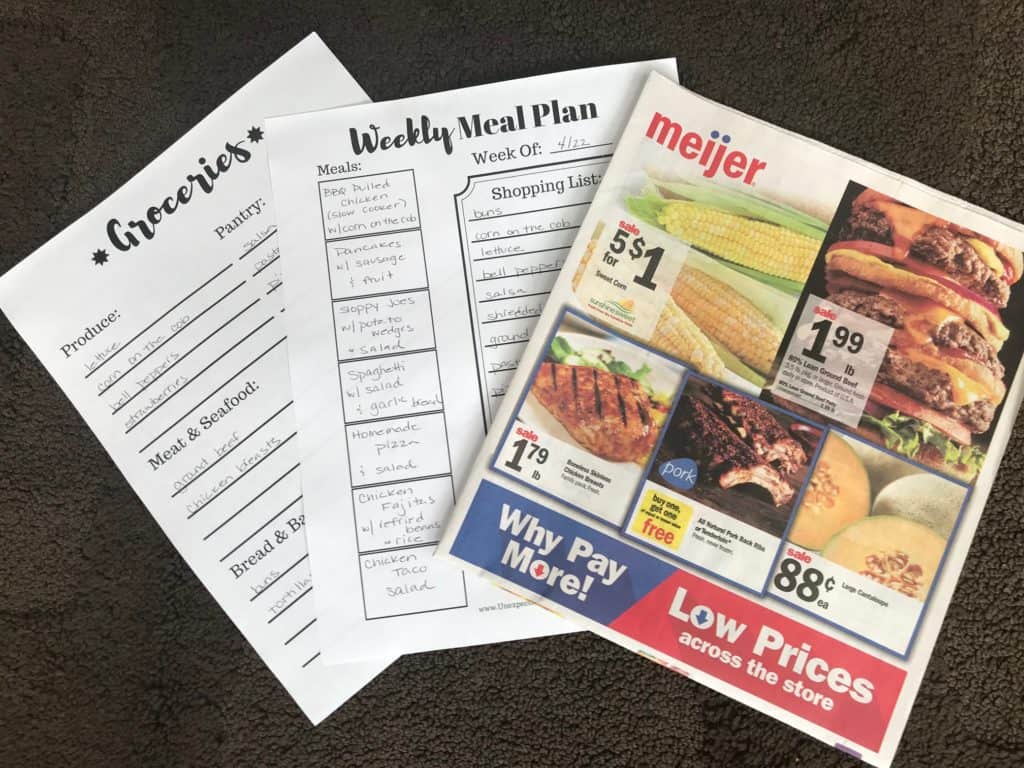
Use ingredients in multiple meals
This is especially helpful if you’re a smaller household of one or two.
If you don’t think you’ll eat an entire pot roast at one meal, search for ways to repurpose the leftovers.
A quick Google search just showed me that leftover roast could be made into everything from tacos to shepherd’s pie to soup.
Or if chicken breasts are on sale in the big family pack size, plan 2-3 dinners that use chicken this week.
Have some meatless dinners
Even at those loss leader prices, meat is more expensive than most other food ingredients.
Try adding some meatless meals to your weekly meal plan.
Don’t forget to plan for things besides dinner
Dinners are the first thing people think of when they plan out their meals. But since we need to eat and drink throughout the day, don’t forget to add those items to your list.
As you make your grocery list, don’t forget to include stuff for:
- Breakfasts
- Lunches
- Snacks
- Beverages
This will help you avoid running through the drive-thru for breakfast, lunch, or a snack when you’re in a hurry.
Keep your meal plan simple, flexible, and realistic
Know you’ll be exhausted and frazzled by Friday evening?
Put a frozen pizza on your grocery list.
Think you love to cook while scrolling Pinterest, but in reality it’s not your favorite?
Just plan to make really simple dishes.
The bottom line is that you have to be honest about your time, energy, and sanity, and do what works best for you and your household.

Cheap grocery list for a month
Here’s a budget-friendly list of foods for a monthly grocery list for inspiration:
- 2-4 loaves of bread
- 1-2 packages of tortillas
- Peanut butter
- Jelly
- Bag of dried beans
- Bag of rice
- Canister of oats
- Pasta
- Apples
- Potatoes
- Carrots, broccoli, zucchini (or other sale-priced veggies)
- Lettuce or spinach
- 2-3 whole chickens (or sale-priced chicken thighs or breasts)
- 2-4 lbs of ground beef or turkey (whatever is on sale)
- Canned tomatoes
- Milk
- Yogurt
- Cheese
- 3 dozen eggs
- Garlic
- Frozen vegetables
Even fresh foods, dairy products, and lean proteins can be attainable without runing your grocery bill.
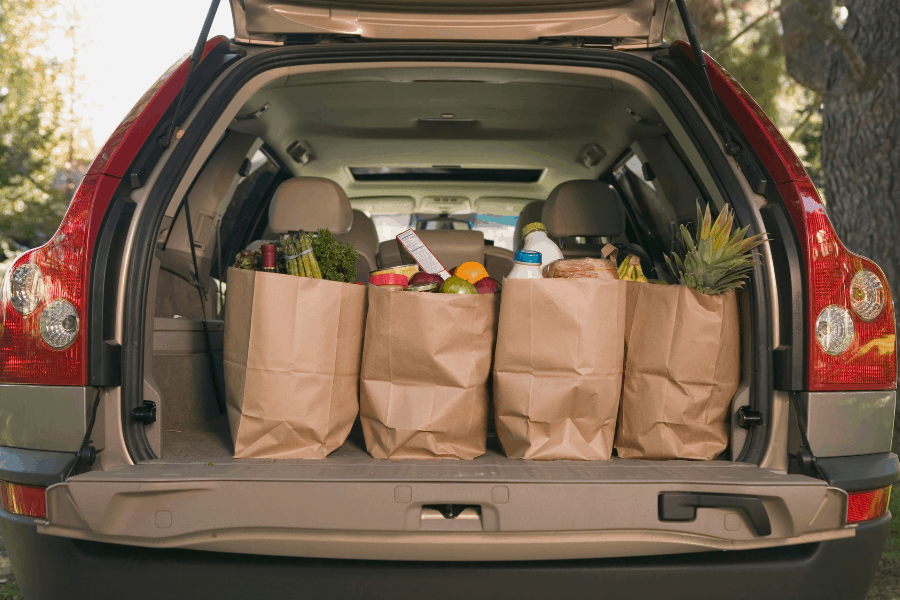
Meals to Make on a Tight Budget
If you’re wondering what meals you can make with this list of the cheapest foods, here are some affordable meal ideas you can cook and eat when you’re living on a tight budget.
Cheap Breakfast Ideas
Oatmeal or Cream of Wheat with a banana or apple
Toast with peanut butter and banana
Scrambled eggs with salsa
Omelet with spinach, broccoli, zucchini, or onion
Potato hash with eggs and veggies
Pancakes or waffles
Cereal
Breakfast tacos or burritos with scrambled eggs and veggies
Cheap Lunch Ideas
Peanut butter and jelly sandwich with apple or banana
Egg salad sandwich
Grilled cheese
Baked potato with salsa
Tuna sandwich
Wrap with tortilla and chicken and veggies (or whatever leftovers you have on hand)
Macaroni and cheese
Ramen noodles
Cheap Dinner Ideas
Beans and rice
Fried rice
Bean burritos
Baked pasta or casserole
Chili (and turn the leftovers into chili mac!)
Chicken noodle soup
Tacos
BBQ Pulled Chicken (in the slow cooker)
Homemade burgers
Spaghetti
Quesadillas
Sloppy Joes
Pizza (using homemade or store-bought dough, or english muffins, bagels, or pita bread)
Breakfast for dinner
Meatloaf
Salad
Ready to buy the cheapest groceries and shop on a budget?
I really hope this list of the cheapest foods to buy on a budget has inspired you to save money on groceries!
Just by buying more affordable or cheaper groceries, you can have more room in your budget to pay your bills and live within your means.
There are even plenty of healthy options for nutritious foods, so healthy eating isn’t out of your reach.
With some forward thinking and a bit of planning, you can save yourself a ton of money and grief!
P.S. Don’t forget to also check out:
- How to Get Started Meal Planning: 10 Easy Tricks You Can Try Today
- 5 Easy Meal Planning Strategies for Beginners
- Create Quick & Cheap Meals with these 30 Pantry Staples
- 30 Delicious Ways to Use a Pound of Ground Beef


